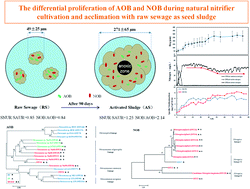The differential proliferation of AOB and NOB during natural nitrifier cultivation and acclimation with raw sewage as seed sludge†
Abstract
Nitrifier immigration from sewers to wastewater treatment systems is attracting increasing attention for understanding nitrifier community assembly mechanisms, and improving process modeling and operation. In this study, nitrifiers in raw sewage were cultivated and acclimated in a sequencing batch reactor (SBR) for 90 days to investigate the characteristics of the influent nitrifiers after immigration. During the experiment, specific nitrite utilization rate (SNUR) exceeded specific ammonia utilization rate (SAUR) when floc size reached 224 ± 46 μm, and nitrogen loss occurred at the same time. The ratio of nitrite oxidizing bacteria (NOB) to ammonia oxidizing bacteria (AOB) increased from 0.84 to 2.14 after cultivation. The Illumina MiSeq sequencing showed that the dominant AOB was Nitrosomonas sp. Nm84 and unidentified species, and the three most abundant Nitrospira were Nitrospira defluvii, Nitrospira calida, and unidentified Nitrospira spp. in both raw sewage and cultivated activated sludge. The shared reads of raw sewage and activated sludge were 48.76% for AOB and 89.35% for Nitrospira. These indicated that nitrifiers, especially NOB, immigrated from influent can survive and propagate in wastewater systems, which may be a significant hinder to suppress NOB in the application of advanced nitrogen remove process based on partial nitrification in the mainstream.



 Please wait while we load your content...
Please wait while we load your content...